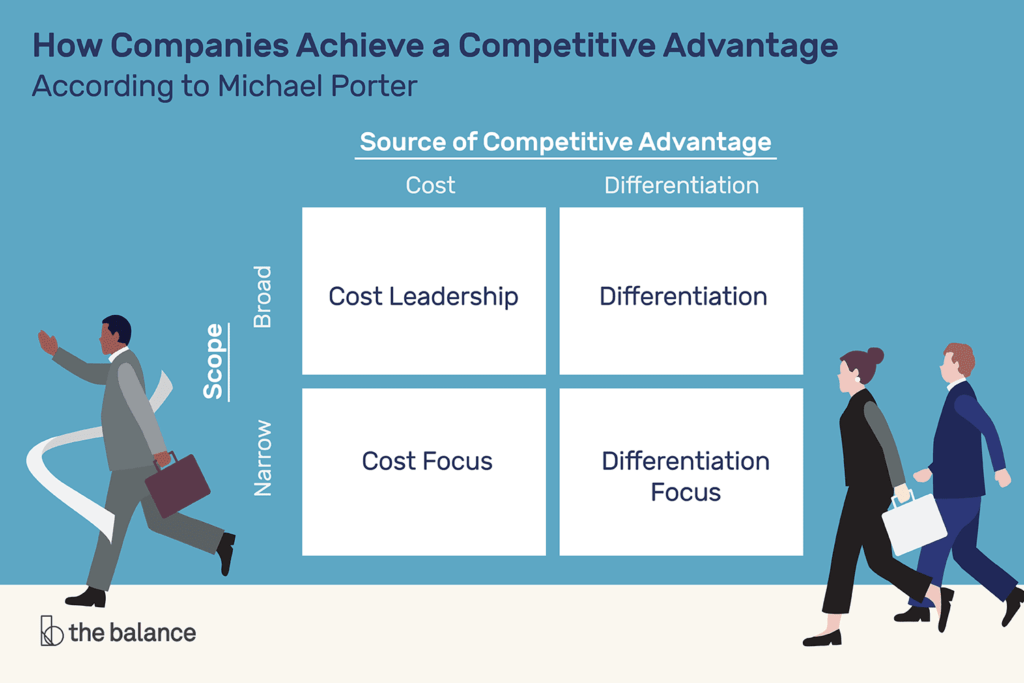How to Gain Competitive Advantage – Porters Generic Strategies
In today’s competitive business landscape, it is vital for companies to have a competitive advantage to succeed in the competitive market. A competitive advantage is a unique value that a company has that allows it to outrank its competitors. In order to thrive in the crowded market, every business, whether a small business, startup or large enterprise, needs a clear competitive advantage strategy to achieve a sustainable position in the market. But it’s crucial to decide the best strategy that fits for your business needs. Should you offer a unique product or service, or the cheapest price? Should you focus on a niche market instead of a broad market?
So as a business owner your decisions are very powerful and crucial which will impact every aspect of your organization. So it’s important to get it right. If you are a business owner and struggling to find out the strategy that works out for your business; no worries here comes Porter’s Generic Strategy which help you to make the best choice.
Michael Porter in 1985 introduced the four generic strategies in his book called ” Competitive Advantage: Creating and Sustaining Superior Performance.” As per Porter’s theory the only way a firm can gain competitive advantage if by offering greater value than their competitors.
Porter’s Four Generic Strategies
- Cost Leadership – Choosing to be the cheapest in the industry
- Differentiation – Create the most unique and desirable products in the industry
- Focus – Choosing to focus exclusively on a niche; further, it divided into Cost Focus and Differentiation Focus

Cost Leadership
Cost leadership is a strategy that involves achieving the lowest cost structure in the industry, where businesses aims on reducing the cost of operations and charging lower price than their competitors. This strategy is based on the idea that if a company can produce goods or services more efficiently than its competitors, it can either charge lower prices or maintain higher profit margins.
Example: Amazon, Walmart
📣 How to Become a Cost Leader
- Leverage Economies of Scale
- Invest in New technology and innovation
- Employing tight cost control
- Creating Low cost production facility
- Having efficient transportation and logistics
- Negotiating power with suppliers
📣Perks of Cost Leader
- Scaling your profit margins
- Capturing larger market share
- Investing the profit in various forms like different business, shareholder value etc.
- Become more competitive in the market
Differentiation
Creating unique products or services that are perceived as being more valuable than those of competitors. Firm makes its product or services more unique to stand apart from competitors. Due to the uniqueness usually the firms price their offering higher than their competitors.
Example: Emirates, Apple
📣How to Become More Unique Provider
- Building Strong Brand
- Delivering High-quality Product or Services
- High Customer Satisfaction Level
📣Perks of Differentiation Strategy
- Entering into new markets to diversify revenue
- Scaling the current revenue through upselling
- Expanding marketing channels with new product features
- Building a community within your customer base around new features
- Enhancing customer loyalty
Cost Focus Strategy
Cost focus strategy is an advancement of cost leadership strategy. As the name suggests it includes both Cost Leader and Focus. The term “Focus” refers focusing on a niche market, either by industry or geography, and become the expert in delivering for that industry. The “Cost” refers same as the cost leader where firms focus on becoming the low cost producer in the industry.
📣Perks of Cost Focus Strategy
- Opening the doors for partnerships with companies in a similar industry
- Building the credibility for the brand
- Building relationships with key customers where they turn as loyal customers
Differentiation Focus Strategy
Differentiation focus strategy is an advancement of Differentiation strategy. As same as the cost focus this strategy also aims on two aspects, where “Focus” refers focusing on a niche market and the “differentiation” refers to address the special needs of the particular niche by offering unique products or services.
📣Perks of Differentiation Focus Strategy
- Scaling Cross-selling among the customers
- Innovating additional services to sell as auxiliary products
Example: Mercedes-Benz, Rolex, Netflix
Porter’s generic strategies are a valuable tool for businesses of all sizes. By understanding and applying these strategies, businesses can increase their chances of achieving sustainable competitive advantage.
In addition to the four main strategies discussed above, there are a number of other things that companies can do to gain a competitive advantage, such as:
- Building a strong team: A company’s most important asset is its people. By hiring and retaining the best talent, companies can gain a competitive advantage.
- Creating a strong company culture: A strong company culture can help to attract and retain top talent, and it can also boost employee morale and productivity.
- Adapting to change: The business world is constantly changing, so it is important for companies to be able to adapt to change. Companies that are able to adapt to change are more likely to be successful in the long run.
The best strategy for gaining a competitive advantage will vary depending on the company and the industry. However, all of the strategies discussed above can be effective in helping companies to achieve their goals.
